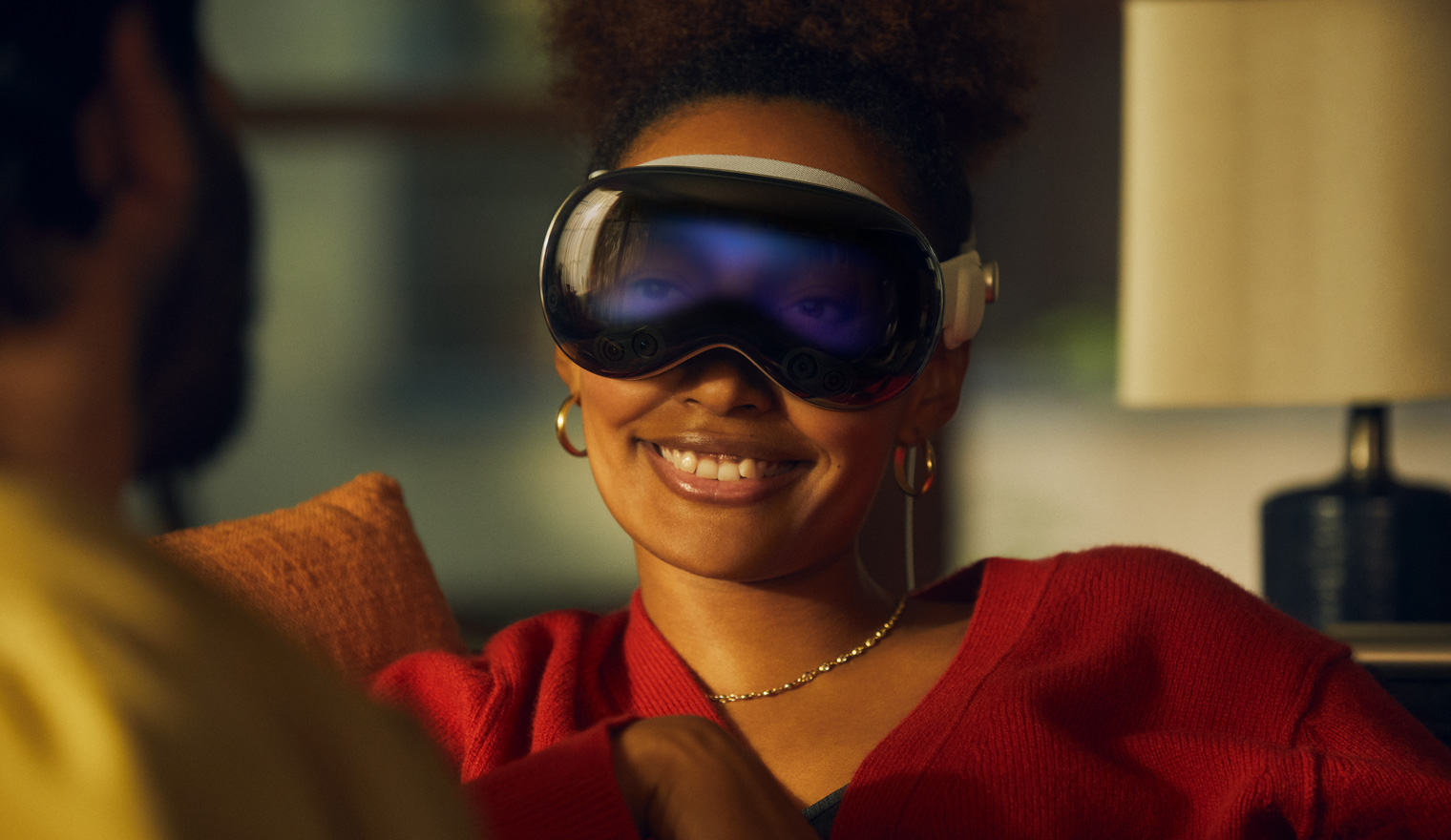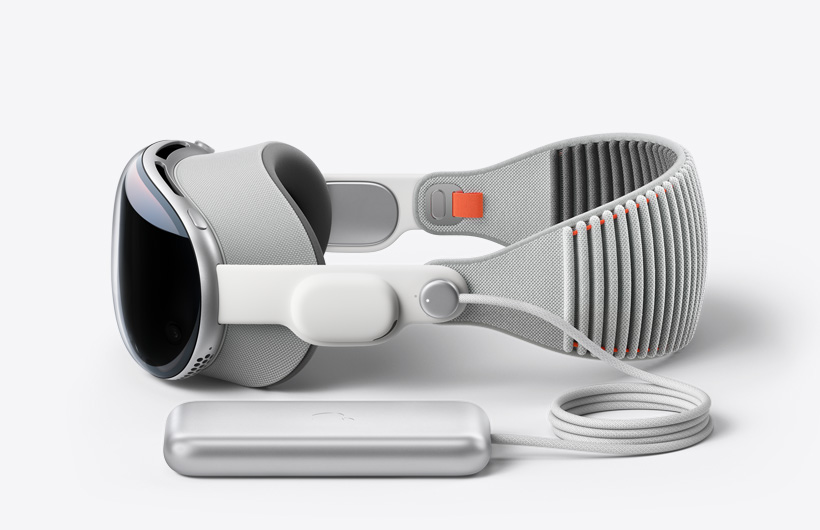Apple reveals $3,500 Vision Pro AR headset that puts Meta's top-tier goggles to shame
The Vision Pro offers more than 4K resolution per eye, controller-less hand and eye tracking, and a new "VisionOS."
I have no need for a $3,500 augmented reality headset that turns my regular computer screen into a virtual computer screen floating in the middle of my apartment, but I regret to say that Apple's unmatched ability to hype up a gadget has worked on me: its new Vision Pro AR headset, which is releasing next year, looks cool, even if it costs more than a lot of OLED TVs.
Here are some of the Vison Pro features Apple revealed at its WWDC event today:
- Micro-OLED display with 23-million pixels across two "postage stamp"-sized panels, which allows it to display virtual 4K screens
- Hand and eye tracking without controllers or external sensors, plus voice control
- Downward-facing cameras so that you don't have to hold your hands in front of your face to use gesture controls
- If a person approaches you while you're immersed in a 3D environment, it'll detect and display them, which is kinda cool
- A knob you can rotate to control the "immersion-level of environments"—how much of the 3D space you see instead of the real world
- A curved OLED screen on the front which shows nearby people your eyes, which looks terrifying in videos, but apparently projects your eyeballs as the correct perspective for each viewer (it's called "EyeSight," which is already a word, Apple)
- A button for taking 3D photos and videos
- Avatars called Personas made by scanning your face (might turn out creepy, but certainly more interesting than what Meta's showing)
- VisionOS, an operating system "designed from the ground up for spatial computing"
- Not-so-good: It uses an external battery pack that only lasts for two-hours
Previously, I've made fun of the idea that people are going to stand in empty offices with goggles on their faces, pointing at floating spreadsheets when they could just be using a regular PC. I still think it's silly, but gee, Apple makes it look so much cooler than Mark Zuckerberg does.
We still haven't reached RayBan glasses territory—this is still a headset like the $1,000 Meta Quest Pro—but the one-piece curved glass front is cool touch, even if I'm weirded out by the magnified-looking eyeballs it displays, which apparently will look correct in-person.
During its WWDC keynote, Apple spent a lot of time talking about Vision Pro's applications, which range from doing the stuff you'd do on an iPhone to capturing and watching 3D movies and playing games. It was a long presentation that concluded the WWDC keynote (the "one more thing"), and you can watch it in full here, but the gist is that the Vision Pro sets itself apart in the way Apple products usually do: by being a complete, self-contained system rather than an interface for existing PCs. It has its own OS, and it's not clear at the moment whether or not we'll be able to hook the Vision Pro up to a Windows PC to use it like a regular VR headset.
Hand tracking and screen resolution
The tech still being young, it's mainly the most basic specs of new AR or VR headsets that get me curious: tracking and resolution. As for tracking, the Vision Pro is free of external sensors like the Meta Quest, but unlike the Quest it's also controller-free. Meta can do hand tracking without a controller, too, but it perhaps speaks to Apple's confidence that it hasn't even announced Vision Pro controllers. I'm a fan of the downward-facing cameras that let you gesture without raising your arms, although the absence of controllers in the announcement probably mostly indicates that Apple views the Vision Pro as a productivity, communication, and passive entertainment device much more than it does a gaming device—I haven't tried playing a game with hand gestures alone, but I feel like I'd want buttons.
The really big upgrade over other consumer goggles is the resolution: Vision Pro promises 23 million pixels across two screens, which is more than 4K resolution per eye. The Meta Quest Pro's two screens don't come close at 1800x1920 each.
Keep up to date with the most important stories and the best deals, as picked by the PC Gamer team.
Over 4K per eye sounds amazing, but simulated demo videos don't give a true sense of what the field of view is like—Microsoft's Hololens did not live up to the promises of stage demos in that respect. Apple claims that "a specially designed three‑element lens creates the feeling of a display that's everywhere you look," which is big if true, but a see-it-to-believe it sort of thing.
I'm sure there are plenty of others, but the two most apparent flaws are a short battery life—just two hours with an external battery pack (connected by a cable that will surely snag on stuff) before you have to charge the pack or plug the headset into something—and, of course, the price. $3,500 is a hell of a lot of money for the first iteration of a device that, like other VR/AR headsets, will surely get a lot better within a few years.
Then again, people spend over $1,000 on iPhones, so maybe gadget enthusiasts will bite on the Vision Pro now while mere gadget enjoyers wait for the price to come down on this kind of AR experience.
There's a lot of skepticism on the PC Gamer team that all this AR/VR stuff is anything more than just a novel fad for rich people—something like 3D TVs that'll eventually be forgotten—but personally, I think it's here to stay. After losing interest in my old Oculus Rift CV1 for a period, I've started using it regularly again over the past year, and it's not even a good headset by today's standards. Granted, I mostly just play a boxing game, and I certainly don't plan to drop $3,500 on a Vision Pro when it releases next year, but I'm afraid that I do think it looks pretty cool.
Granted, I doubt the Vision Pro will be a better gaming device than the incoming Meta Quest 3, since Apple hasn't designed it with gaming primarily in mind (same goes for the Meta Quest Pro). For one thing, I wouldn't want to fight pretend boxers with $3,500 on my head.

Tyler grew up in Silicon Valley during the '80s and '90s, playing games like Zork and Arkanoid on early PCs. He was later captivated by Myst, SimCity, Civilization, Command & Conquer, all the shooters they call "boomer shooters" now, and PS1 classic Bushido Blade (that's right: he had Bleem!). Tyler joined PC Gamer in 2011, and today he's focused on the site's news coverage. His hobbies include amateur boxing and adding to his 1,200-plus hours in Rocket League.




